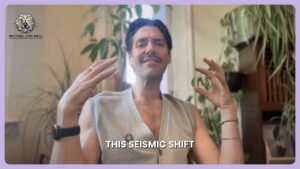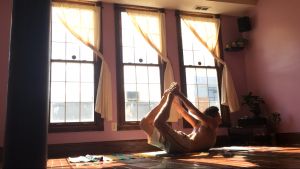Reimagining Ashtanga Community Leadership
Introduction
For nearly two decades, I’ve witnessed the profound impact that leadership styles have on yoga communities. As both student and teacher in the Ashtanga tradition, I’ve experienced firsthand how the decisions, behaviors, and communication patterns of those in positions of authority shape not just the technical transmission of the practice, but the very culture in which we learn and grow.
When I first began teaching Ashtanga yoga over 10 years ago, I consciously and unconsciously replicated the leadership models I had experienced. Some of these served our community well; others perpetuated patterns that limited growth and authentic connection. Like many teachers, I found myself caught between reverence for tradition and the practical reality that our understanding of both human movement and effective teaching continues to evolve.
The question that has increasingly occupied my teaching practice is this: How might we create yoga communities that honor the depth and wisdom of tradition while embracing the vulnerability, transparency, and adaptability that contemporary leadership research tells us is essential for healthy organizations?
This essay—and the series that follows—explores this question through the leadership frameworks offered by organizational theorists Peter Senge and Patrick Lencioni. Their work, though developed primarily for business contexts, offers compelling insights for yoga communities grappling with questions of authority, innovation, and authentic transmission of practice.
The leadership models we choose—consciously or unconsciously—directly impact how students experience the practice, how teachers develop their skills, and ultimately, how the tradition itself evolves. By examining these dynamics directly, my hope is to contribute to a conversation about creating yoga communities that are both deeply rooted and courageously evolving.
Senge’s Five Disciplines: A Framework for Learning Yoga Communities
Peter Senge’s concept of the “learning organization” offers a powerful lens through which to view yoga communities. In his seminal work, “The Fifth Discipline,” Senge outlines five core practices that enable organizations to continuously learn, adapt, and evolve. When applied to Ashtanga yoga communities, these disciplines suggest a path toward more resilient, authentic, and growth-oriented spaces for practice.
Personal Mastery: Beyond Perfect Postures
In Ashtanga circles, we often conflate personal mastery with postural achievement—the ability to perform advanced asanas with apparent ease. Yet Senge’s conception goes deeper, describing “the discipline of continually clarifying and deepening our personal vision, of focusing our energies, of developing patience, and of seeing reality objectively.”
For yoga practitioners, true personal mastery integrates technical skill with broader awareness: understanding our bodies’ unique architecture, recognizing how emotions manifest physically, and cultivating the discernment to adapt practice responsibly. For teachers, it means ongoing development not just in demonstrating postures, but in communication, observation, and the subtle art of meeting students where they are.
In my own teaching, I’ve witnessed how communities that celebrate this broader view of mastery—rather than primarily rewarding postural achievement—create space for deeper, more sustainable engagement with the practice. Students feel empowered to develop at their own pace, without the shame or discouragement that can come from narrower definitions of “advancement.”
Mental Models: Examining Our Yoga Assumptions
The Ashtanga method carries powerful mental models—shared assumptions about what constitutes “correct” practice, how progress occurs, and where authority resides. Many of these models serve practitioners well, providing structure and continuity. Others may unconsciously limit growth.
Consider the mental model that authentic practice must follow the precise sequence and counted vinyasa method codified in mid-20th century Mysore. This model offers valuable structure, but when held rigidly, can prevent communities from incorporating emerging insights about biomechanics, trauma-informed teaching, or accessibility.
In my experience, communities thrive when they create regular opportunities to surface and examine these mental models. This might look like teacher development sessions that discuss the reasoning behind methodological choices, or community conversations that distinguish between core principles and adaptable techniques. When we bring assumptions into the light, we can consciously choose which to preserve and which to reconsider.
Shared Vision: Beyond Standardization
Ashtanga communities often default to standardization as a path to cohesion—uniform teaching protocols, consistent sequencing, and predicable authorization structures. While consistency has benefits, Senge’s discipline of shared vision suggests something more dynamic: a collectively held picture of the future that people commit to creating together.
What might it look like for Ashtanga communities to develop genuine shared vision? In my teaching, I’ve found value in regular community gatherings that explore questions like: What are we practicing for? How do we hope students feel in our space? What values guide our decisions about who teaches and how? These conversations build alignment around purpose rather than just procedure.
A community united by shared vision has flexibility that standardization alone cannot provide—the ability to adapt methods while remaining true to core values and aspirations.
Team Learning: Collaborative Teaching Development
The traditional guru-shishya model typically positions learning as a one-way transmission from teacher to student. Senge’s team learning discipline offers a complementary approach where collective intelligence emerges through dialogue, skillful discussion, and collaborative problem-solving.
In practical terms, this might look like peer teaching sessions where instructors observe and learn from each other, case study discussions about challenging teaching scenarios, or cross-pollination with adjacent movement disciplines. My most significant growth as a teacher has often come through these kinds of collaborative learning environments, where multiple perspectives illuminate blind spots and spark innovation.
Embracing team learning doesn’t diminish the value of lineage or expert guidance—rather, it creates conditions where that wisdom can be integrated more fully into a community’s collective practice.
Systems Thinking: The Fifth Discipline
The “fifth discipline” that integrates all others is systems thinking—the ability to see interrelationships rather than linear cause-effect chains, to recognize patterns of change rather than static snapshots.
Applied to yoga communities, systems thinking invites us to recognize how our teaching methods, governance structures, economic models, and cultural norms interact to create the student experience. When a community struggles with accessibility, for instance, the issue rarely stems from a single cause, but emerges from the interaction of physical space, teaching methodology, scheduling, pricing, and cultural messaging.
By developing systems awareness, we become more effective stewards of our yoga communities. We can anticipate how changes in one area might affect others, identify leverage points for positive transformation, and approach persistent challenges with greater nuance and effectiveness.
Lencioni’s Five Dysfunctions: Building Healthy Yoga Communities
While Senge offers a framework for learning and adaptation, Patrick Lencioni’s work on organizational health provides complementary insights into the relational dynamics that either enable or prevent communities from thriving. His model of the “Five Dysfunctions of a Team” can be powerfully applied to yoga communities, offering a roadmap for more authentic, effective relationships among teachers, students, and administrators.
Trust: The Foundation of Practice
Lencioni defines foundational trust as the confidence that team members’ intentions are good and there is no reason to be protective or careful around each other. In yoga communities, this translates to psychological safety—the shared belief that we can be vulnerable, make mistakes, and express doubts without fear of judgment or exclusion.
Building this trust requires yoga leaders to model vulnerability first. When I share my own ongoing questions about the practice, acknowledge the limitations of my understanding, or openly discuss teaching mistakes, it creates permission for others to do the same. This stands in contrast to traditional models where teachers project certainty and students display deference.
Trust also requires consistent behavior over time—when community members experience leaders as reliable, consistent in their values, and honest in their communication, the foundation for all other aspects of community health is established.
Healthy Conflict: Beyond Harmony at All Costs
Many yoga communities avoid conflict, prioritizing surface harmony and deferring to authority rather than engaging in the productive disagreement that drives growth. Lencioni’s framework suggests that healthy communities engage in unfiltered, constructive debate around ideas.
In Ashtanga contexts, this might look like thoughtful discussions about adaptations to traditional sequences, approaches to assisting, or the integration of complementary practices. When these conversations focus on finding the best path forward rather than protecting egos or hierarchies, they enrich rather than threaten the tradition.
In my experience, establishing norms for healthy disagreement—focusing on issues rather than personalities, assuming good intentions, and explicitly separating discussion from decision-making—creates the conditions for these productive exchanges. Communities that develop this capacity tend to be more innovative and responsive to student needs.
Commitment: Clarity and Buy-In
The third dysfunction in Lencioni’s model is lack of commitment, which stems from ambiguity about decisions and priorities. In yoga communities, this often manifests as unclear teaching protocols, inconsistent messaging about practice expectations, or ambiguous paths for student and teacher development.
Creating commitment doesn’t require perfect consensus. Rather, it emerges when community members feel their perspectives have been genuinely heard and when decisions, once made, are clearly communicated and consistently implemented. For instance, when introducing modifications to traditional practice approaches, explaining the reasoning, acknowledging various viewpoints, and providing clear guidelines helps build collective commitment.
I’ve found that regular community meetings, transparent decision-making processes, and explicit documentation of teaching approaches all contribute to stronger commitment among both teachers and students.
Accountability: Holding the Space Together
In many yoga communities, accountability flows primarily downward—teachers hold students accountable for consistent practice, correct technique, and appropriate behavior. Lencioni’s framework suggests that peer accountability is equally important for community health.
What might this look like in practice? Teachers giving each other feedback on teaching approaches. Studio managers and senior practitioners checking in with each other about adherence to shared values. Students empowered to respectfully address concerns directly with teachers rather than simply accepting or leaving.
Creating cultures of mutual accountability requires deliberately building these feedback channels, normalizing constructive critique, and reinforcing that providing feedback is an act of care rather than criticism.
Results: Defining Success Beyond Numbers
The fifth dysfunction in Lencioni’s model is inattention to results—the failure to define and focus on collective outcomes. In yoga communities, we often default to measuring success through metrics like class attendance, social media following, or the number of advanced practitioners.
Deeper measures of results might include: How many students maintain sustainable, injury-free practices over years? To what extent do community members experience greater ease, presence, and compassion in their daily lives? How effectively does the community create accessible entry points for diverse practitioners?
By explicitly defining success in terms of these more meaningful outcomes, communities can align their teaching approaches, resource allocation, and cultural norms accordingly. This shifts focus from growth for its own sake to growth in service of genuine transformation.
The Integrated View: Leadership That Serves the Practice
When combined, Senge’s learning organization disciplines and Lencioni’s organizational health framework offer a comprehensive approach to yoga community leadership. The learning disciplines create the conditions for technical excellence and adaptive capacity, while the health model ensures the relational foundation necessary for collective learning and growth.
This integrated approach suggests yoga leadership that:
• Balances reverence for tradition with openness to evolution
• Models both technical mastery and personal vulnerability
• Creates structures for collaborative learning and mutual accountability
• Defines success in terms of sustainable transformation rather than superficial metrics
Such leadership doesn’t diminish the profound wisdom of the Ashtanga lineage—rather, it creates the conditions for that wisdom to be more fully embodied, thoughtfully transmitted, and widely accessible in our contemporary context.
Conclusion: The Path Forward
The application of Senge’s and Lencioni’s frameworks to Ashtanga yoga communities reveals both challenges and opportunities. Traditional leadership models have successfully preserved technical aspects of the practice for decades, yet many communities now find themselves at an inflection point—facing questions about accessibility, adaptation, and the evolution of teaching methodologies.
The frameworks explored in this essay suggest a path that honors tradition while creating space for necessary evolution. This path requires:
Conscious Leadership Cultivation: Rather than assuming that technical mastery automatically confers leadership capability, communities benefit from deliberately developing leadership skills among teachers and senior practitioners. This includes fostering systems thinking, facilitating productive dialogue, building psychological safety, and managing healthy accountability structures.
Structural Reimagining: The organizational structures within many yoga communities evolved organically rather than by design. Intentionally creating structures that support learning, trust, and sustainable growth may require reimagining authorization processes, teacher development pathways, decision-making protocols, and community governance.
Cultural Transformation: Ultimately, the most profound shift occurs at the level of culture—the shared assumptions, values, and norms that shape daily behavior. Moving from cultures of hierarchy and standardization toward cultures of collaborative learning and mutual accountability requires persistent attention and modeling from those in positions of influence.
As a teacher who has spent fifteen years immersed in these questions, I believe the Ashtanga tradition is robust enough to withstand—and indeed benefit from—this kind of thoughtful examination and evolution. The practice itself teaches us that transformation comes through sustained attention and disciplined action. By applying these same qualities to our community structures and leadership approaches, we honor the essence of the practice even as its forms adapt to contemporary needs and understandings.
The essays that follow will explore specific implementations of these frameworks—examining case studies of communities navigating these transitions, offering practical tools for teacher development, and suggesting approaches to common challenges in yoga community leadership. My hope is that these explorations contribute to a broader conversation about creating yoga spaces where both the technical precision and the transformative potential of the practice can flourish for generations to come.



